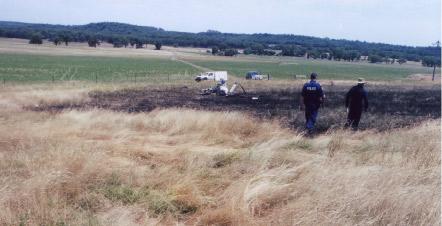On 22 January 2006, at approximately 1930 Eastern Daylight-saving Time, the pilot of a Brantly International Inc B-2B helicopter, registered VH-FBE departed Mount Dapper property near Gulgong, NSW on a private flight to gain further experience on the helicopter.
After approximately 15 minutes, the helicopter was observed to commence a slow descent. An observer at the property homestead became concerned that the projected flight path may lead the helicopter to collide with the powerlines crossing the property. The observer reported seeing the helicopter contacting the powerlines, tumbling in the air and crashing to the ground. The helicopter was engulfed by fire and destroyed. The pilot, the sole occupant, was fatally injured.
The investigation did not find evidence of any pre-existing condition that would have contributed to the accident. All of the helicopter and its systems were accounted for at the accident site. All damage and the separation of parts of the helicopter were consistent with the onset of excessive loads experienced during impact with the wire and ground.
The observer reported that the powerlines had been on the property for a long time and their location was known by the pilot. The pilot had other power lines on the property marked with red coloured markers and had purchased two similar markers with the intention of having them fitted to the powerlines involved in the accident.
It is likely that the pilot became preoccupied with the operation of the helicopter and either forgot that there were powerlines in the area or did not see the powerlines.
FACTUAL INFORMATION
On 22 January 2006, at approximately 1930 Eastern Daylight-saving Time, the pilot of a Brantly International Inc B-2B helicopter, registered VH-FBE, departed Mount Dapper property near Gulgong, NSW, on a private flight to gain further experience on the helicopter.
After approximately 15 minutes, the helicopter was observed to commence a slow descent. An observer at the property homestead became concerned that the projected flight path may lead the helicopter to collide with the powerlines crossing the property. The observer reported seeing the helicopter contacting the powerlines, tumbling in the air and crashing to the ground. The helicopter was engulfed by fire and destroyed. The pilot, the sole occupant, was fatally injured.
Figure 1: The accident site

Note: The powerlines post is visible at the right corner of the photo. The powerlines extended to the left, almost overhead of the wreckage.
The investigation did not find evidence of any pre-existing condition that would have contributed to the accident. All of the helicopter and its systems were accounted for at the accident site. All damage and the separation of parts of the helicopter were consistent with the onset of excessive loads experienced during impact with the wire and ground.
The helicopter had recorded 170.1 hours in service at the time of the accident. It had flown approximately 65.7 hours since the last periodic inspection completed in November 2005.
The pilot was qualified on the type and approved for low flying. He held a valid medical certificate. At the time of the accident, he had accumulated a total of approximately 184 hours.
It was reported that the sky was clear, temperatures in the high twenties with a light and variable south-easterly breeze.
The observer reported that the powerlines had been on the property for a long time and their location was known by the pilot. The pilot had other power lines on the property marked with red coloured markers and had purchased two similar markers with the intention of having them fitted to the powerlines involved in the accident.
It is likely that the pilot became preoccupied with the operation of the helicopter and either forgot that there were powerlines in the area or did not see the powerlines.


